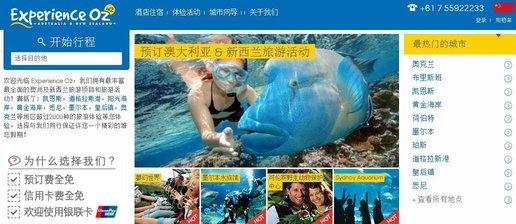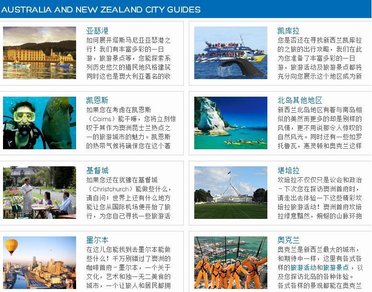Australians look to Chinese market to drive digital conversions
Planning a holiday and searching for activities or outings in a native language makes life much task easier for travellers. Australian travel experience provider Experience Oz is targeting the rapidly growing Chinese market in Australia with a new multilingual website.
Offering a specific language site may sound a logical decision, but it does take a deep understanding of a target audience to make the most of any tailored e-commerce project.
Recently, Australian travel experience provider Experience Oz introduced its fully functional Chinese site. The initiative, which is focused on offering the growing Chinese tourist market access to over 2000 tours, activities and experiences from around Australia and New Zealand, required some significant architectural changes to the company’s application to handle the multilingual content and purchase process.
The site is equipped with up-to-date information and live booking options.

According to the company, the e-commerce site has been launched to meet increasing demand from Chinese tourists for independent travel options. China is now Australia’s fastest growing and most valuable market for international visitors with 620,000 visits last year, and the site is also expected to help 336,000 Chinese speakers living in Australia. The site features new payment types such as UnionPay, which is the payment method of choice in China.
Here EyeforTravel’s Ritesh Gupta talks to Clint Gudenswager, general manager of Experience Oz, about the initiative.
EFT: Can you highlight the sort of preparation that went into the launch of Chinese e-commerce site?
CG: The project required some significant architectural changes to our application to handle the multilingual content, purchase process and to fit into our current affiliate programmes. We also had to factor in how it would work on mobiles and tablets. Once this was done, we broke the project into several sub tasks and worked collaboratively to achieve the final goal.
There was also a significant amount of research into some of the lesser-known aspects of Groovy and Grails, Chinese customer expectations, how they were going to pay, what products were of interest to them and general consumer trends. It’s been a good experience for all of us involved.
EFT: Tell us about the booking engine, technology and content strategy. And what stands out as far as the tours, attractions and activities category is concerned?
CG: The look and feel of the current booking engine has not changed, just the content. Although translating some 300 site-wide messages was fun.
Our site is developed in Groovy and Grails and the available plug-ins did not fit our particular requirements well, so we developed our own.
As for content, being in the industry for quite some time, we had a good understanding on what was popular with Chinese consumers. For the type of tours, it is significantly different than the traditional western and domestic markets.
EFT: What was the most challenging part of working on this assignment?
CG: The unknown! If we had to list the top few:
- Developing our own plug-in to handle the multilingual content,
- Improving our system cache (in our application and through a CDN),
- The customised views and content in terms of appropriate ordering of products.
- Another large part of the project was how to track product updates and pricing to ensure these are also updated in Chinese.
EFT: How does your Chinese site differ from your main site and how has it been tailored for this particular audience?
CG: The actual site is the same, same URL just different views. It has the same address – www.experienceoz.com.au – but it will load automatically in Chinese if your language is set to Chinese. Or you can use the drop down language menu. The order of products and some minor content changes are the only noticeable difference to the consumer.
EFT: What have you learned from the experience?
CG: That each market is more different than you expect, and to never underestimate the amount of work involved in developing a transactional multilingual site - the translation is actually the easy bit.

EFT: The site was developed in Groovy and Grails 2.0 and uses a Content Delivery Network (CDN). Can you explain how does make the site more user-friendly?
CG: There are a couple of factors that stand out:
· Firstly, Groovy and Grails provides us a fast development framework thus we can invest more time in developing our user interface.
· Secondly, the CDN ensures that all users across the globe enjoy a fast web experience, which we all know has a significant part to play in conversions and ranking in Google and Baidu search engines.
EFT: How has the site’s functionality, design and conversion evolved? For instance, how much time does it take today to arrive at a decision and complete a booking?
CG: We never stop redesigning our site. Just when we think we have nailed it something new or another idea will come along. I think the web is moving fast and consumer trends are also changing. Who would have thought that two years ago that 20% of our conversions would be mobile? The question we ask ourselves with every single decision is - is this going to make it easier and faster for the customer?
EFT: In what way can you lower the rate of site abandonment?
CG: Quality of content, speed and good site structure across desktop, mobile devices and tablets. I am still amazed at the number of big players in the travel market who still don’t have a mobile or tablet (offering).

